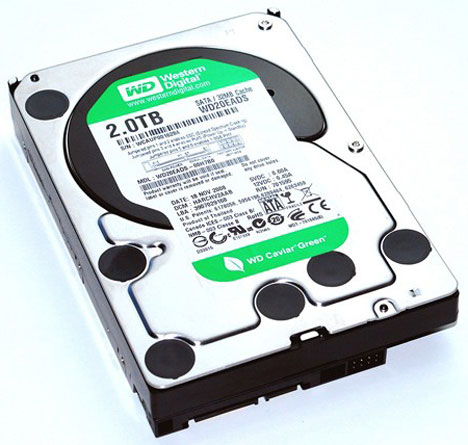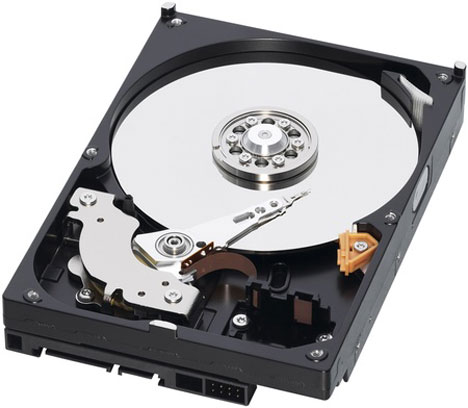
After an earlier leak by an Australian distributor, Western Digital have officially announced their breakthrough 2TB Caviar Green SATA HDD, which marks an industry first as the highest capacity single disk hard drive. The drive tops Seagate’s 1.5TB Barracuda announced back in July and uses the same four platter design, only manages to squeeze a massive 500GB into each one.
The drive uses Perpendicular Magnetic Recording Technology to achieve the huge capacity (400 Gb/in2 areal density) and comes with a 32MB cache and claims of cool and quiet operation. WD’s StableTrac tech secures both ends of the motor shaft to reduce vibration and IntelliPower balances spin speed to achieve better acoustical and energy performance.
The drive is a single 3.5-inch SATA internal hard drive, unlike some drives that are really two drives set up in a RAID configuration. The 2TB model, the WD20EADS, has a retail price of $299 and is available now.

Full Press Release Below:
LAKE FOREST, Calif. Jan. 27 /PRNewswire-FirstCall/ — WD (NYSE: WDC) today announced the first 2 terabyte (TB) hard drive – the world’s highest capacity drive and the latest addition to WD’s popular, environmentally friendly, cool and quiet, WD® Caviar® Green™ hard drive family. This new 3.5-inch platform is based on WD’s industry-leading 500 GB/platter technology (with 400 Gb/in2 areal density) with 32 MB cache, producing drives with capacities of up to 2 TB.
“While some in the industry wondered if the end consumer would buy a 1 TB drive, already some 10 percent of 3.5-inch hard drive sales are at the 1 TB level or higher, serving demand from video applications and expanding consumer media libraries,” said Mark Geenen, President of Trend Focus. “The 2 TB hard drives will continue to satisfy end user’s insatiable desire to store more data on ever larger hard drives.”
WD Caviar Green is one of the most successful product lines in the company’s recent history with its third-generation GreenPower™ technology, now providing 2 TB of proven reliable storage for today’s high-resolution files and graphics. WD Caviar Green drives are designed for use in USB/FireWire®/eSATA external hard drives, desktop computers, workstations, and desktop RAID environments.
“Saving power without sacrificing storage capacity is what consumers want, and what many businesses are requiring today. With the launch of the new WD Caviar Green 2 TB hard drive, customers receive the additional capacities needed to operate today’s highly advanced programs and high-resolution digital files while using less power than typical drives with similar performance and capacities,” said Jim Morris, WD senior vice president and general manager of client systems.
Rock Solid Mechanical Architecture, Cool, Quiet Hard Drives
A number of advanced technologies enable the speed, capacity and performance of WD’s Caviar Green 1.5 TB and 2 TB hard drives. Those include: StableTrac™, which secures the motor shaft at both ends to reduce system-induced vibration and stabilize platters for accurate tracking during read and write operations; IntelliPower™, which fine-tunes the balance of spin speed, transfer rate and caching algorithms designed to deliver both significant power savings and solid performance; IntelliSeek™, which calculates optimum seek speeds to lower power consumption, noise, and vibration(1); and NoTouch™ ramp load technology, which is designed to ensure the recording head never touches the disk media resulting in significantly less wear to the recording head and media, as well as better drive protection while in transit.Availability and Pricing
The WD Caviar Green 2 TB is available at select resellers and distributors. MSRP for the WD Caviar Green 2 TB hard drives (model WD20EADS) is $299.00 USD. More information about WD Caviar Green desktop drives may be found on the company’s Web site at http://wdc.com/en/products/Products.asp?DriveID=576
Sources:
Western Digital (Press Release) via Register Hardware